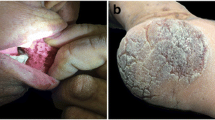Abstract
A case of well-differentiated adenocarcinoma (Borrmann type 3) of the stomach in a 76-year-old man associated with the typical skin manifestations of acanthosis nigricans and with multiple protruding lesions showing epithelial hyperplasia of the esophagus is reported. The advanced tumor was located in the cardiac region of the stomach, and measured approximately 8cm in diameter, with partial invasion to the esophagus. The associated cutaneous lesions were characterized by hyperpigmentation and by protruding verrucous papules on the torso, head, face, neck, upper extremities, perineum, and inguinal region. Histologically, the protruding skin lesions showed keratinocytes proliferation throughout the epidermis, resulting in diffhyperkeratosis, papillomatosis, and acanthosis of the skin. Immunohistological analysis showed coexpression of transforming growth factor alpha (TGF-a) and epidermal growth factor (EGF) receptors in the tumor from the stomach. It is reasonable to conclude from this evidence that gastric carcinoma cells secrete TGF α in an autocrine for auto-stimulation. EGF receptor expression was also noted on the papillomatous hyperplasia of the cutaneous lesion. Serum level of TGF α, determined by an enzyme-linked immunosorbent assay, was high (144pg/ml; normal, 22.0 ±16pg/ml (Mean±SD)). Serum TGF α abruptly decreased to 49pg/ml on day 7 after the total gastrectomy, and then gradually increased to 77pg/ml within 28 days. Amelioration of the cutaneous lesions and the protruding lesions in the esophagus was observed after surgical resection of the gastric carcinoma. This suggests that the TGF α stimulates the proliferation of keratinocytes involved with EGF receptor. Large amounts of circulating TGF α in the blood over a long period released by the primary tumor seem to act as an endocrine-like mechanism causing epidermal and esophageal epithelial cells to proliferate. There is a possible link in the pathogenesis of the acanthosis nigricans as a cutaneous paraneoplastic syndrome, and epithelial hyperplasia of the esophagus.
Similar content being viewed by others
References
Braun-Falco O, Plewig G, Wolff HH, et al. Dermatology. Berlin Heidelberg Tokyo New York: Springer, 1991;455–457.
Ellis DL, Kafka SP, Chow JC, et al. Melanoma, growth factors, acanthosis nigricans, the sign of Leser-Trelat, and multiple acrochordons. N Engl J Med 1987;317:1582–1587.
Wilgenbus K, Lentner A, Kuckelkorn R, et al. Further evidence that acanthosis nigricans maligna is linked to enhanced secretion by the tumour by transforming growth factor alpha. Arch Dermatol Res 1992;284:266–270.
Tahara E, Growth factors and oncogenes in human gastrointestinal carcinomas. J Cancer Res Clin Oncol 1990;116:121–131.
Yonemura Y, Takamura H, Ninomiya I, et al. Interrelationship between transforming growth factor-α and epidermal growth factor receptor in advanced gastric cancer. Oncology 1992;49:157–161.
Japanese Research Society for Gastric Cancer. The general rules for gastric cancer study. 12th ed. (in Japanese). Tokyo: Kanehara, 1993.
American Joint Committee on Cancer. Handbook for staging of cancer. 4th ed. Philadelphia: JB Lippincott, 1993.
Tomiya T, Fujiwara K. Serum levels of transforming growth factor-α in patients after partial hepatectomy as determined with an enzyme-linked immunosorbent assay. Hepatology 1993;18:304–308.
Winkler ME, O'Connor L, Winget M, et al. Epidermal growth factor and transforming growth factor α bind differently to epidermal growth factor receptor. Biochemistry 1989;28:6373–6378.
Yasui W, Hata J, Yokozaki H, et al. Interaction between epidermal growth factor and its receptor progression of human gastric carcinoma. Int J Cancer 1988;41:211–217.
Nasim M, Thomus DM, Alison MR, et al. Transforming growth factorα expression in normal gastric mucosa, intestinal metaplasia, dysplasia and gastric carcinoma-an immunohistochemical study. Histopathology 1992;20:339–343.
Schreiber AB, Libermann TA, Lax I, et al. Biological role of epidermal growth factor-receptor clustering: Investigation with monoclonal anti-receptor antibodies. J Biol Chem 1983;258:846–853.
Nanney LB, Magid M, Stoscheck CM, et al. Comparison of epidermal growth factor binding and receptor distribution in normal human epidermis and epidermal appendages. J Invest Dermatol 1984;83:385–393.
Coffey RJ, Derynck R, Wilcox JN, et al. Production and autoinduction of transforming growth factor-alpha in human keratinocytes. Nature 1987;328:817–820.
Gottlieb AB, Chang CK, Fanelli PB, et al. Detection of transforming growth factor a in normal, malignant, and hyperproliferative human keratinocytes. J Exp Med 1988; 167:670–675.
Ozawa S, Ueda M, Ando N, et al. Prognostic significance of epidermal growth factor receptor in esophageal squamous cell carcinomas. Cancer 1989;63:2169–2173.
Author information
Authors and Affiliations
Rights and permissions
About this article
Cite this article
Koyama, S., Ikeda, K., Sato, M. et al. Transforming growth factor-alpha (TGF α)-producing gastric carcinoma with acanthosis nigricans: An endocrine effect of TGF α in the pathogenesis of cutaneous paraneoplastic syndrome and epithelial hyperplasia of the esophagus. J Gastroenterol 32, 71–77 (1997). https://doi.org/10.1007/BF01213299
Received:
Accepted:
Issue Date:
DOI: https://doi.org/10.1007/BF01213299




